罗宾斯管理学第十版第二单元robbins_PPT
罗宾斯管理学山西大学管理学院中文版精PPT课件
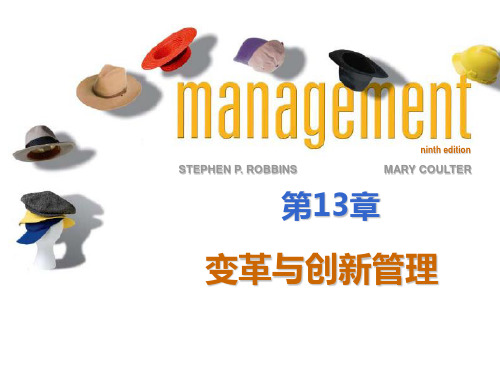
通过非结构化的群体互动来 改变行为的一种方法
敏感性 训练
帮助团队成员在互动中 了解其他人是怎么想和
怎么做的活动
依靠一外部咨询者帮 助管理者认识人际关 系过程是如何影响工
作开展的方式
调查反馈
更有效的
团队建设
人际工作关系
过程咨询
组际发展
改变工作小组内各成 员之间相互的看法、
认知和成见
.》课件》课件
山西大学管理学院 范建平
.》课件》课件
山西大学管理学院 范建平
5–20
变革能动型组织的特点
• 将现在和将来联系起来 • 使学习成为一种生活方式 • 积极支持和鼓励日常的改进和变革 • 保证多样化的团队 • 鼓励不同意见 • 保护突破 • 整合技术 • 建立和深化信任
.》课件》课件
山西大学管理学院 范建平
5–21
激发创新
.》课件》课件
山西大学管理学院 范建平
5–8
变革的类型
• 结构变革
➢ 变革组织的结构成份或它的 结构设计
• 技术变革
➢ 采用新的设备、工具或者操 作方法,替代原有技术或直 接引进新的
❖ 自动化: 某些原由人完成的 工作,由机器来代替
❖ 计算机化
• 人的变革
➢ 改变人的态度、期望、认知 和行为
➢ 组织发展
.》课件》课件
力量
市 场 法律与规制
变革的
……
外部压力 技 术
经济变化 劳动市场
.》课件》课件
山西大学管理学院 范建平
5–3
公司战略
工作队伍
变革的 内部压力
技术和设备
员工态度
.》课件》课件
山西大学管理学院 范建平
管理学原理与实践教材ppt课件

表 1-3 效率和效果
效率
资源使用
目标达成
目标
低 浪费
高 实现
效果
管理的科学性(效果):强管理的调其客观规律性,做正确地事; 管理的艺术性(效率):强调其灵活性与创造性。正确地做事。
管理的复杂性------科学性与艺术性 1.管理的科学性:管理是指导人们进行社会化大生产的科学, 探索的是管理的一般规律,提出普遍的理论、原则、方法等,它涉及到经济学、哲学、社会学、历史学、心理学和各种工程技术科学,是一门交叉型的边缘性科学。管理科学是在总结管理工作的客观规律基础上形成的,可以指导管理实践,其本身也在不断发展。
人际技能
概念技能
技术技能
技能要求
三、管理者的技能要求
*
*
管理人员的技能要求 1.技术技能 技术技能是指使用某一专业领域内有关的程序、技术、知识和方法完成组织任务的能力。 2.人际技能 人际技能是指与处理人际关系有关的技能,即理解、激励他人并与他人共事的能力 3.概念技能 概念技能是指综观全局、认清为什么要做某事的能力,也就是洞察企业与环境要素间相互影响和作用的能力。
人际关系角色
1.首脑。作为组织的首脑,每位管理者有责任主持一些仪式,比如接待重要的访客、参加某些职员的婚礼、与重要客户共进午餐等等。
2、领导者。由于管理者管理着组织,他就对该组织成员的工作负责,比如,在大多数组织中,管理者通常负责雇佣和培训职员。
3.联络人。管理者在他的垂直指挥链之外与人接触的联络角色。
根据法国工业经济学家亨利·法约尔提出的管理职能观点,管理者要执行某些活动或者职能
管理职能
计划 确定目标、制定战略、 开发辅助计划以协调活动
组织 决定做什么、 如何做、谁来做
管理学原理与实践教材(PPT 68页)
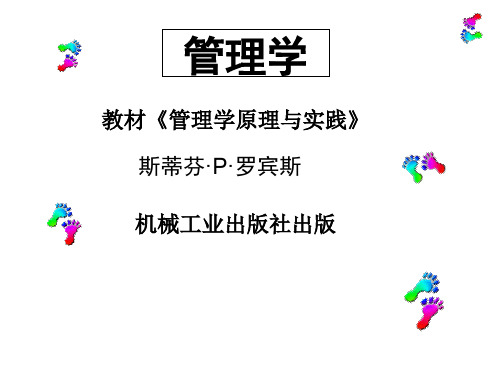
– 将一些人系统地安排在一起,以达到某些特定的 目标而做出的刻意安排。
• 组织的共性
– 特定的目的 – 在一起工作的人员 – 结构考虑周全的系统化
• 组织涵盖的范围
– 便利店到国家足球队,从学校俱乐部到国际知名 企业,从学校到慈善机构······
管理者与非管理类员工
• 管理者
– 在一个组织中直接督导他人工作的那些人
1.管理世界
国务院发展研究中心
2.企业管理
中国企业管理协会
3.销售与市场
中原传媒出版集团
4.外国经济与管理 上海财经大学
5.经济管理
中国社会科学院
由于管理既是一门科学同时又是一门艺术 ,所以我们在学习完科学之后,还应该在具 体实践中具体问题具体分析,通过实践经验 的积累,以及个人的性格、胆识、魄力、人 格的魅力在具体的管理实践中获得成功!
教材简介
全书共7篇21章,主要内容有:管理者与管理; 管理的演进;组织文化与环境;国际管理;社会责任 与管理道德;决策;计划的基础;战略管理与企业家 精神;计划工具与技术;组织的基础;组织与职务设 计选择;人力资源管理;变革与创新管理;行为的基 础;理解群体与团队工作;激励员工;领导;沟通与 人际交往技能;控制的基础;信息控制系统;作业管 理
管理学
教材《管理学原理与实践》 斯蒂芬·P·罗宾斯 机械工业出版社出版
作者简介
斯蒂芬·P·罗宾斯博士(Stephen P. Robbins)曾 就职于壳牌石油公司和雷诺金属公司。有着丰富的实践 经验,并先后在布拉斯加大学、协和大学、巴尔的摩大 学、南伊利诺伊大学、圣迭戈大学任教。是美国著名的 管理学教授,组织行为学的权威,他撰写管理教科书在 美国的1000多所大学,以及遍布加拿大、拉丁美洲、澳 大利亚、新西兰、亚洲、欧洲等的数百所大学中使用。 在中国管理学界和企业界,罗宾斯博士的《管理学》是 最受欢迎和采用量最大的教材,且连续数年畅销不衰。
管理学,罗宾斯,版,英文Robbinsfom

1-26
Why Are Customers Important?
Consistent, high-quality customer service is essential to survival
Copyright © 2015 Pearson Education, Inc.
1-27
Why Is Innovation Important?
1-19
Which Approach Takes the Prize?
Functions ☑
Roles
☐
Copyright © 2015 Pearson Education, Inc.
1-20
What Skills Do Managers Need?
Conceptual Skills
Interpersonal Skills
1-22
Why Study Management?
We all have a vested interest in improving how organizations are managed.
Copyright © 2015 Pearson Education, Inc.
1-23
Why Study Management? (cont.)
1-6
Copyright © 2015 Pearson Education, Inc.
1-7
What Titles Do Managers Have?
Top Managers • Make decisions about the direction of an organization
Middle Managers • Manage other managers
管理学教学资料-10erobbins_ppt10 - r
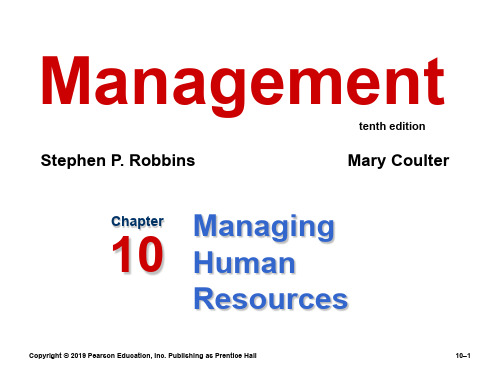
tenth edition
Stephen P. Robbins
Mary Coulter
Chapter Managing
10 Human
Resources
Copyright © 2019 Pearson Education, Inc. Publishing as Prentice Hall
关注生 产环节 的管理
重视市 场销售 的管理
偏向资 产运营 的管理
强调以发挥人 的潜力为主的 人力资源管理
1. The Importance of Human Resource Management (HRM)
• As a significant source of competitive advantage
• To improve organizational performance
High performance work practices lead to both high individual and high organizational performance.
Copyright © 2019 Pearson Education, Inc. Publishing as Prentice Hall
Copyright © 2019 Pearson Education, Inc. Publishing as Prentice Hall
10–4
Learning Outcomes
Follow this Learning Outline as you read and study this chapter.
• Describe how organizations are dealing with work-life balance issues.
罗宾斯《管理学》第十版 英文课件 第二章
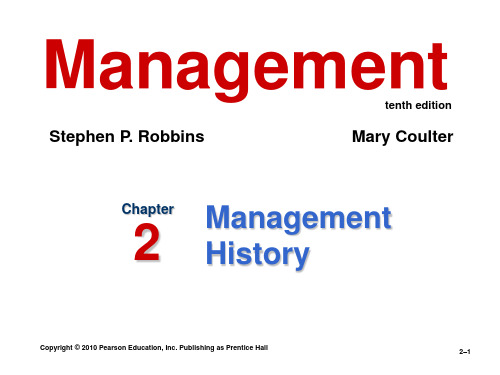
2.4 Behavioral approach.
• Describe the contributions of the early advocates of
OB. • Explain the contributions of the Hawthorne Studies to the field of management. • Discuss how today’s managers use the behavioral approach.
Substituted machine power for human labor Created large organizations in need of management
Copyright © 2010 Pearson Education, Inc. Publishing as Prentice Hall 2–5
2–2
2.2 Classical Approach.
• • •
Copyright © 2010 Pearson Education, Inc. Publishing as Prentice Hall
Learning Outcomes
2.3 Quantitative Approach.
• Explain what the quantitative approach has contributed to the field of management. • Describe total quality management. • Discuss how today’s managers use the quantitative approach.
Management
Stephen P. Robbins
罗宾斯管理学原理英文版第10版PPT (1)[32页]
![罗宾斯管理学原理英文版第10版PPT (1)[32页]](https://img.taocdn.com/s3/m/bbe15120f90f76c660371a02.png)
Copyright © 2017, 2015, 2013 Pearson Education, Inc. All Rights Reserved.
Learning Objective 1.1
Tell who managers are and where they work.
Copyright © 2017, 2015, 2013 Pearson Education, Inc. All Rights Reserved.
Copyright © 2017, 2015, 2013 Pearson Education, Inc. All Rights Reserved.
Learning Objective 1.2
Define management.
Copyright © 2017, 2015, 2013 Pearson Education, Inc. All Rights Reserved.
1.1 Tell who managers are and where they work. 1.2 Define management. 1.3 Describe what managers do. 1.4 Explain why it’s important to study management. 1.5 Describe the factors that are reshaping and redefining
Copyright © 2017, 2015, 2013 Pearson Education, Inc. All Rights Reserved.
Exhibit 1-3 Efficiency and Effectiveness
Copyright © 2017, 2015, 2013 Pearson Education, Inc. All Rights Reserved.
罗宾斯《管理学》原版讲义PPT精选文档

➢ Discretionary behavior that is not a part of an employee’s formal job requirements, but which promotes the effective functioning of the organization.
8th edition Steven P. Robbins
Mary Coulter
Copyright © 2005 Prentice Hall, Inc. All rights reserved.
LEARNING OUTLINE
Follow this Learning Outline as you read and study this chapter.
14–3
L E A R N I N G O U T L I N E (cont’d)
Follow this Learning Outline as you read and study this chapter.
Perception
• Explain how an understanding of perception can help managers better understand individual behavior.
• Discuss how managers can shape behavior.
14–4
Understanding Individual Behavior
• Organizational Behavior (OB)
➢ The actions of people at work
斯蒂芬·P·罗宾斯-管理学(第10版)

斯蒂芬·P·罗宾斯-管理学(第10版)1. 介绍《斯蒂芬·P·罗宾斯-管理学(第10版)》是管理学领域的经典教材之一。
本书由著名管理学家斯蒂芬·P·罗宾斯(Stephen P. Robbins)撰写,从理论和实践两方面全面介绍了管理学的基本原理和方法。
本书在全球范围内广受欢迎,并被广泛应用于大学本科和研究生的管理学教育中。
2. 内容概述《斯蒂芬·P·罗宾斯-管理学(第10版)》共分为12个章节,内容涵盖了管理学的主要领域和理论。
以下是各章节的简要介绍:第1章:管理与组织本章介绍了管理学的基本概念和定义,并探讨了组织的概念和作用。
还介绍了管理学研究的历史和发展。
第2章:管理环境本章主要讲述管理学与环境的关系,包括宏观环境和微观环境对管理决策的影响。
介绍了政治、法律、经济、技术等因素对组织和管理的影响。
第3章:管理者的角色本章主要介绍了管理者的角色和职责,包括计划、组织、领导和控制等方面的内容。
还讨论了管理者的能力要求和领导风格选择的问题。
第4章:决策与管理本章着重讲述决策的过程和方法,包括问题诊断、信息收集、方案评估和选择等步骤。
介绍了常见的决策问题和解决方法。
第5章:组织结构与设计本章探讨了组织结构的概念和原理,介绍了各种常见的组织结构形式,并讨论了组织设计的原则和方法。
第6章:管理控制与系统本章讲述了管理过程中的控制和反馈机制,介绍了管理控制的概念和方法。
还介绍了系统理论在管理控制中的应用。
第7章:领导与管理本章主要介绍了领导与管理之间的关系,讨论了领导能力和领导风格的重要性。
还探讨了如何培养和发展领导能力。
第8章:团队与团队建设本章讨论了团队的概念和特点,介绍了团队建设的原则和方法。
还介绍了团队合作和团队动力的重要性。
第9章:人力资源管理本章主要讲解了人力资源管理的基本原理和方法,包括招聘、培训、绩效管理、激励和薪酬等方面的内容。
管理学-组织结构设计 ppt课件

Exhibit 10-2: Economies and Diseconomies of Work Specialization
10–11
Foxconn 富士康流水线
10–12
P
1.2 Work Specialization
Today’s view-
Important mechanism to help employees be more efficiency-McDonald
P265 D
A process of creating or changing an organization’s structure, involving decisions about six key elements:
创造和改变组织结构的六要素:
① Work specialization ② Departmentalization ③ Chain of command ④ Span of control ⑤ Centralization and decentralization ⑥ Formalization
4. Traditional Organizational Designs 传统的组织 结构
10–4
1. Designing Organizational Structure 组织结构设计
10–5
P265 D
Organizational Structure Chart
• D Organizational Structure 组织结构
The formal arrangement of jobs within an organization. 组织内部对工作的正式安排
10–6
组织的维度
罗宾斯_管理学_10版_英文PPT_14
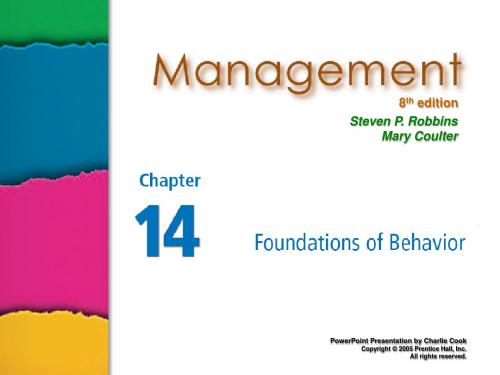
14–2
Understanding Individual Behavior 理解个体行为
• Organizational Behavior (OB)
The actions of people at work
组织行为学
人们在工作中的活动
• Dual Focus of OB
Individual behavior
• Attitudes 态度 • Employee Productivity 员工生产率 • Absenteeism 旷职率 • Turnover 流动率 • Organizational Citizenship 组织公民行为 • Job Satisfaction 工作满意度
14–5
• Personality 人格
Copyright © 2005 Prentice Hall, Inc. All rights reserved. 14–7
Job Involvement and Organizational Commitment 工作参与和组织承诺
• Job Involvement 工作参与
指员工认同自己的工作、积极从事工作,并且认为工作表现足以彰显个人 价值的程度。 高度工作参与的员工,强烈认同并且关心自己所从事的工作 员工的工作参与程度愈高,旷职率及离职率愈低
• 员工满意度与旷职率
当员工对工作越满意,其旷职率会比较低
• 员工满意度与流动率
当员工对工作越满意,流动率越低;当员工对工作越不满意,流动性越高 流动率会被员工绩效所影响 对绩效优异的员工而言,工作满意度对流动率的影响较低,组织会尽其所能 留住绩效优异的员工
• 员工满意度与客户满意度
们对自己的工作、工作小组、上级主管或组织的感觉。
管理学原理robbins-PPT13

and regulations ➢ Technology ➢ Labor market ➢ Economic changes
• Internal Forces
➢ Changes in organizational strategy
➢ Workforce changes
.
13–11
Organizational Development Techniques
.
Exhibit 13.3
13–12
Managing Resistance to Change
• Why People Resist Change?
➢ The ambiguity and uncertainty that change introduces ➢ The comfort of old habits ➢ A concern over personal loss of status, money,
unpredictable ➢ Creates both threats and opportunities
• Managing change is an integral part of every manager’s job.
.
13–5
Forces for Change
• External forces
.
13–9
Three Categories of Change
Exhibit 13.2
.
13–10
Types of Change
• Structural
➢ Changing the organization’s structure or its structural components
罗宾斯管理学原理PPT课件

第9页/共49页
态度调查
• 态度调查 • 态度调查包括一系列的问题,用于了解员工对自己的工作、工作小组、上级主管部门或组织的感受 • 态度调查为管理者提供员工对组织和他们的工作的任职的反馈
10–10
第10页/共49页
态度的重要性
• 对管理者的意义 • 态度是对潜在的行为问题的一种预警: • 管理者应该在激发员工积极的工作态度方面有所作为,因为这样可以降低缺勤率和辞职率 • 态度影响员工的行为: • 管理者应该关注于帮助提高员工的工作热情,从而提升工作满意度 • 员工将试图减少失调,除非: • 管理者能够找到造成这种失调的外部来源 • 管理者能够为这种失调提供奖赏作为补偿
为什么要了解组织与个人行为?
• 组织行为学 (OB) • 关注人们在工作中的活动
• 组织行为学关注的焦点 • 个体行为 • 态度、人格、认知、学习和激励 • 群体行为 • 规范、角色、团队建设、领导和冲突
• 组织行为的目的 • 为了解释、预测和影响行为
10–1
第1页/共49页
图表 10.1 组织犹如一座冰山
第32页/共49页
10–32
图表 10–7 群体行为模型
第33页/共49页
10–33
群体结构
• 角色
• 角色指的是在一个社会单元中,人们对于占据特定位置的个体所期望的一套行为模式。这些角色指向 任务的完成,或者指向维持群体成员的满意度
• 角色冲突: 扮演不同的角色,需要不同的经验 • 角色的不确定性: 角色预期的不确定性
图表 10.2 霍兰德的人格类型与职业范例
Source: Based on J. L. Holland, Making Vocational Choices: A Theory of Vocational Personalities and Work Environments (Odessa, FL: Psychological Assessment Resources, 1997).
- 1、下载文档前请自行甄别文档内容的完整性,平台不提供额外的编辑、内容补充、找答案等附加服务。
- 2、"仅部分预览"的文档,不可在线预览部分如存在完整性等问题,可反馈申请退款(可完整预览的文档不适用该条件!)。
- 3、如文档侵犯您的权益,请联系客服反馈,我们会尽快为您处理(人工客服工作时间:9:00-18:30)。
• Economic indicators • Substitution effect • Qualitative • Jury of opinion • Sales force composition • Customer evaluation
Copyright © 2010 Pearson Education, Inc. Publishing as Prentice Hall B–8
Management
tenth edition
Stephen P. Robbins
Mary Coulter
Appendix
B
Planning Tools and Techniques
B–1
Copyright © 2010 Pearson Education, Inc. Publishing as Prentice Hall
B–6
Assessing the Environment (cont’d)
• Forecasting Techniques
Quantitative forecasting
Applying a set of mathematical rules to a series of hard data to predict outcomes (e.g., units to be produced). Using expert judgments and opinions to predict less than precise outcomes (e.g., direction of the economy).
Copyright © 2010 Pearson Education, Inc. Publishing as Prentice Hall
B–10
Exhibit B–2 Steps in Benchmarking
Source: Based on Y.K. Shetty, ―Aiming High: Competitive Benchmarking for Superior Performance,‖ Long Range Planning. February 1993, p. 42.
Learning Outcomes
Follow this Learning Outline as you read and study this chapter.
Techniques for Assessing the Environment
• List the different approaches to assess the environment.
Copyright © 2010 Pearson Education, Inc. Publishing as Prentice Hall B–13
Exhibit B–3 Types of Budgets
Copyright © 2010 Pearson Education, Inc. Publishing as Prentice Hall
B–11
Allocating Resources
• Types of Resources
The assets of the organization
Copyright © 2010 Pearson Education, Inc. Publishing as Prentice Hall
B–5
Assessing the Environment (cont’d)
• Forecasting
The part of organizational planning that involves creating predictions of outcomes based on information gathered by environmental scanning.
Financial: debt, equity, and retained earnings Physical: buildings, equipment, and raw materials Human: experiences, skills, knowledge, and competencies Intangible: brand names, patents, reputation, trademarks, copyrights, and databases
Qualitative forecasting
• Collaborative Planning, Forecasting, and Replenishment (CPFR) Software
A standardized way for organizatioபைடு நூலகம்s to use the Internet to exchange data.
Copyright © 2010 Pearson Education, Inc. Publishing as Prentice Hall B–7
Exhibit B–1 Forecasting Techniques
• Quantitative • Time series analysis • Regression models • Econometric models
Copyright © 2010 Pearson Education, Inc. Publishing as Prentice Hall
B–12
Allocating Resources: Budgeting
• Budgets
Are numerical plans for allocating resources (e.g., revenues, expenses, and capital expenditures).
May involve reverse engineering of competing products to discover technical innovations.
Copyright © 2010 Pearson Education, Inc. Publishing as Prentice Hall
The process of gathering information about competitors—who they are; what they are doing – Is not spying but rather careful attention to readily accessible information from employees, customers, suppliers, the Internet, and competitors themselves.
B–4
Assessing the Environment
• Environmental Scanning (cont’d)
Global Scanning
Screening a broad scope of information on global forces that might affect the organization.
Copyright © 2010 Pearson Education, Inc. Publishing as Prentice Hall
B–2
Learning Outcomes
Techniques for Allocating Resources
• • • • • • List the four techniques for allocating resources. Describe the different types of budgets. Explain what a Gantt chart and a load chart do. Describe how PERT network analysis works. Understand how to compute a breakeven point. Describe how managers can use linear programming.
Copyright © 2010 Pearson Education, Inc. Publishing as Prentice Hall
B–3
Assessing the Environment
• Environmental Scanning
The screening of large amounts of information to anticipate and interpret change in the environment. Competitor Intelligence
• Explain what competitor intelligence is and ways that managers can do it legally and ethically. • Describe how managers can improve the effectiveness of forecasting. • List the steps in the benchmarking process.
Are used to improve time, space, and use of material resources.
Are the most commonly used and most widely applicable planning technique for organizations.
Has value to firms with significant global interests.
Draws information from sources that provide global perspectives on worldwide issues and opportunities.
